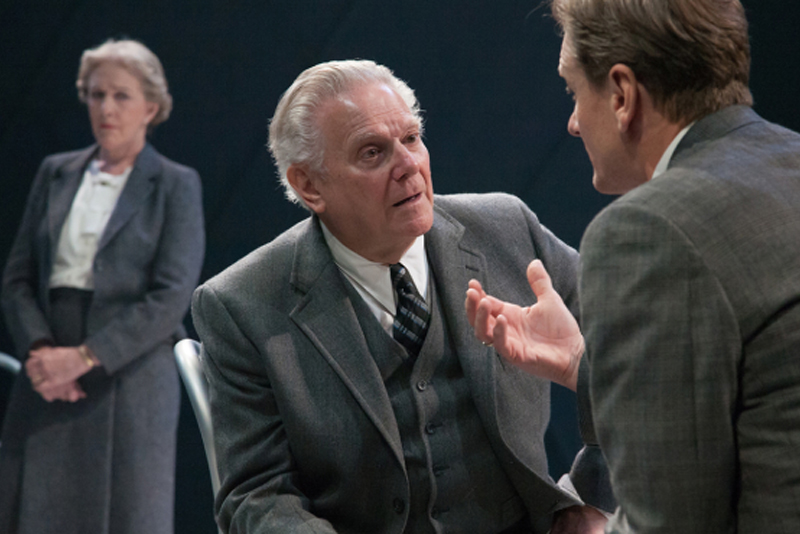“Copenhagen”: Chichester Festival Theatre
Jeremy Malies in West Sussex
26 August 2018
The best theoretical physicists, notably Lawrence Krauss and the late Stephen Hawking, have become our new moral philosophers when arguing that efforts to know the universe may be the best chance of knowing ourselves. It’s a recent development but Michael Frayn may have sensed this 20 years ago when his play Copenhagen opened. He portrays scientists making the broadest possible reflections on the human condition by amassing empirical observation and trying to comprehend phenomena as a whole.
Copenhagen shows a 1941 meeting in which the German physicist Werner Heisenberg paid an unexpected visit to his pre-war colleague and mentor Niels Bohr in Nazi-occupied Denmark. Heisenberg is widely recognized as a founder of quantum mechanics and Bohr would go on to play a significant role at Los Alamos working with Robert Oppenheimer on the Manhattan Project. While there was still confusion as to what might constitute a bomb and what would be a reactor, the pair both knew that nuclear fission could take warfare into another dimension.

Paul Jesson, Charles Edwards and Patricia Hodge. Photo credit: Conrad Blackmore.
Bohr’s wife, Margrethe, is also present in Frayn’s play (she was not a participant in real life) and she becomes an integral part of the conversations. Nothing is simple here and we see the dialogue in multiple versions as recalled by the characters who are now ghosts standing outside the action. Their memories flit from a beleaguered post-WWI Germany in 1921 to the horrific days of the Third Reich.
The Chichester Festival Theatre has revived the play in its Minerva studio space which, with its intimate hexagonal layout and a simple lattice outline on the stage by designer Peter J. Davison, made me think that audience members were electrons whizzing around the characters who could be regarded as three atoms.
Bohr (played by Paul Jesson) reflects on how he used to ski in Norway at such speed that decisions had to be made without conscious thought. In a similar way, Jesson pushes himself to the limits while delivering complex technical dialogue at a pace that leaves nothing between performer and character, with ideas seeming to occur spontaneously. I’ve never seen a factual historical play where distance from the subject matter has been reduced so effectively.
As Heisenberg, Charles Edwards is credible in conveying the kind of courage that may well have prompted him to invent obstacles to developing an atomic bomb once he had observed the Nazi regime and his moral compass had kicked in fully. Edwards is empathetic when he portrays his character as somebody who always viewed the scientific community as a fraternity and though a patriot, will not have partisan views forced on him even by a terrifying set of handlers that included Albert Speer.

Charles Edwards, Paul Jesson, and Patricia Hodge. Photo credit: Conrad Blackmore.
Bohr once said that he was “a mathematically curious entity: not one but half of two.” As Margrethe, an ashen Patricia Hodge is outstanding as she reinforces the brooding ethereal quality of the play. Her character is a device to keep the physics digestible for the audience, and Hodge must also convince in terms of understanding the science as she clarifies, paraphrases and reflects on the conversation of the men often in the manner of a Greek chorus.
Criticisms? Michael Blakemore’s direction (he was also responsible for the premiere) and Davison’s overall design place us with great skill in a quantum universe, but I took issue with Nina Dunn’s video design. Bohr’s eldest son, Christian, drowned aged 17 in a boating accident with his father left tormented by not having tried to rescue him though he had been held back by crew members. Productions need to reference this, but Dunn’s stereotypical projected seascapes seem heavy-handed and alien to the subtlety of everything else that occurs or is inferred on the stage.
Bohr and Heisenberg subsequently gave contrary accounts of what was said at this fateful meeting possibly with the intention of burying the fallout. It should be remembered that Heisenberg created the Uncertainty Principle.
We are taught at school that ‘How?’ is a more intelligent question than ‘Why?’ But here, the first and last questions are ‘Why?’ Why did Heisenberg make a risky visit that might have been seen as treachery? The characters talk almost endlessly without consensus as to what exactly happened at the meeting which left brave audience members trying to identify the nucleus with so much enthusiasm that, as I lingered in the carpark, I heard two debates develop as chain reactions into full-on arguments. Frayn would be thrilled.









